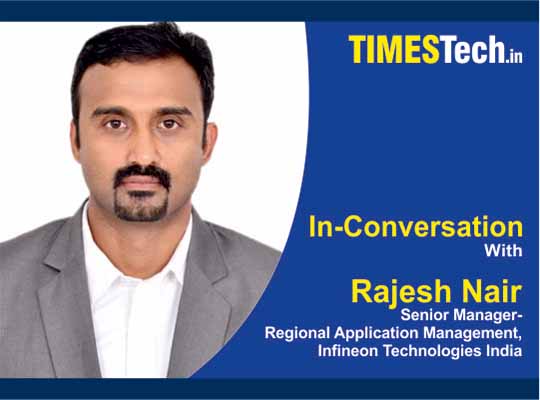As we see, some of the key drivers influencing lighting market are increasing population, data collection & analysis, lighting quality, human centric lighting and energy efficiency. These drivers create market needs like low standby power, compatibility with protocols like DALI, lower output ripples, higher dimming capability, lower system cost etc. emphasizes Rajesh Nair, Senior Manager- Regional Application Management, Infineon Technologies India. Lot more in the edited excerpts below about Infineon’s leadership in LED driver ICs, there major focus in this sector and innovations.
TimesTech Buzz: Infineon is a market leader in LED lighting system designs; kindly share your key product offerings for the India market?
Rajesh: Infineon delivers innovative, high-performance LED Driver ICs solutions with best-in-class technologies that can be used in a broad range of LED lighting applications. The key offerings can be broadly classified into AC-DC LED driver ICs, DC-DC LED driver ICs, Dimming ICs, Linear LED ICs and high voltage MOSFETs. A key portfolio from this is the XDPL range of digital power control ICs offering best in class power factor and highest level of configurability for customers. We also offer advanced components like Microcontrollers, Radar sensors, Bluetooth/ Wi-fi modules and hardware security chips for applications like Smart Lighting, etc.
TimesTech Buzz: There is a growing demand for advanced lighting control, and improved efficiency and cost-effectiveness in the LED Driver ICs market. What is Infineon’s focus and how are you addressing these requirements?
Rajesh: Being a market leader in this industry, Infineon focuses on innovations in creating cost effective, energy efficient devices for all segments including lighting. For example, our XDPL range of Digital flyback controllers are one of its kind in the market offering configurability, lowest system cost, ease of production and highest output quality at the same time. Offered in multiple output configurations including constant voltage, constant current and constant power and multiple topologies like PFC FB and PFC+FB,, the XDPL family remains one of the best solutions for LED drivers in the market now.
Customers can use a single device to produce LED driver modules of different power levels considerably reducing the inventory carrying cost through standardization. Options to program and configure the device helps to reduce the time to market considerably, helping customers to launch their products quickly in this highly dynamic market.
TimesTech Buzz: What are the key drivers influencing Infineon’s LED lighting innovations?
Rajesh: As we see, some of the key drivers influencing lighting market are increasing population, data collection & analysis, lighting quality, human centric lighting and energy efficiency. These drivers create market needs like low standby power, compatibility with protocols like DALI, lower output ripples, higher dimming capability, lower system cost etc. Infineon’s product innovations are always guided by these drivers and aimed at meeting these market requirements.
TimesTech Buzz: What is Infineon’s focus in intelligent lighting systems and do name a few leading offerings in this segment?
Rajesh: Smart and Connected lighting remains one of the largest focus areas for us in the current scenario. There are many applications in this umbrella like Smart Street lighting, energy management based on occupancy detection and counting, human centric lighting etc. to name a few. Our lighting ICs, MOSFETS, Microcontrollers and sensors still remain the leading offerings in this segment.
TimesTech Buzz: Post Infineon’s acquisition of Cypress, how has it enabled the company to target and innovate in new lighting applications.
Rajesh: The acquisition of Cypress was a key highlight for Infineon, also for the lighting business. Advanced components like Bluetooth & Wi-Fi modules, Microcontrollers, PSoC solutions complement the power conversion product range from legacy Infineon. The combined portfolio helps us to effectively address new and upcoming requirements like Smart lighting, Connected lighting, tunable white lighting solutions etc.
TimesTech Buzz: Complexity for supply, communication, sense, control, and actuation has been continuously increasing. How is Infineon offering next-gen LED rear lighting solutions.
Rajesh: To keep the increasing complexity manageable in terms of PCB space but also in terms of power dissipated, the integration of functions and scalability of products became a key factor for the design. Infineon currently offers dedicated solutions for LED control with a benefit from low power consumption and low quiescent current under the brand name of LITIX, to benefit from the advantages of LEDs while providing full protection to the application.
As we head towards autonomous driving (AD), rear LED lighting becomes more than functional signal lighting and acts as a means of communication with other drivers and pedestrians. This introduces new challenges for designers, including expensive and complex wiring from the BCM to the LEDs and high software efforts in order to implement interactive rear lights. Infineon as a market leader, embraces the new challenges that come along with the upcoming architecture and communication evolution.
TimesTech Buzz: Kindly take us through your advancements in DC-DC LED driver ICs?
Rajesh: When it comes to signage lighting our latest addition of linear LED driver ICs can help to fully exploit on reliability and efficiency versus discrete solutions. For LED drivers, especially in two-stage topologies with secondary side buck, we focus on smart features like hybrid dimming, easy interoperability with MCUs and, here also, on the protection of the system and LEDs. For very cost-effective tunable white/multichannel solutions there’s also the possibility to use an active headroom controller instead of a LED Driver IC with nearly the same efficiency.
TimesTech Buzz: Lastly, share with us industry trends you foresee for the LED industry?
Rajest: The onset of pandemic has greatly affected our lives and created newer opportunities for lighting business as a whole. We have started looking at lighting as something beyond illumination. Adding to this is the advent of new technologies like IoT, AI etc. creating paradigm shift in consumers’ choices and requirements. Some of the key trends evolving from these are:-increased focus on Human centric lighting, rising popularity of Smart and Connected lighting, Another trend not to miss here is the increasing popularity of UV-C lighting based disinfection technology.
LED technology has been contributing significantly to reduction of carbon footprint in the past years. In order to exploit further energy efficiency increases topologies like PFC + LLC that were previously deployed mainly in higher power applications are being used more and more in < 100W power range. Infineon has mature and well proven products for these topologies like ICL5102 a combo controller as well as high voltage Mosfets of the P7 family that are enabling high efficiency and small form factor designs.















